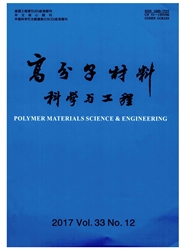

 中文摘要:
中文摘要:
用熔融共混的方法制备了一系列玻璃微珠(GB)含量不同的PP/SAN/GB复合材料。试样断面的SEM结果表明,GB与SAN的亲和力更强,GB选择性分布在分散相SAN中。流变测试结果表明,GB的含量和分布极大地影响着复合材料的流变行为。低含量时(小于15phr)GB的加入对共混体系的流变行为基本无影响,当加入GB量超过一定值(15phr)时体系的复数黏度和动态储能模量才有明显的升高。GB的表面处理改善了GB的分散性,没有改变选择性分布,增加了与聚合物之间的作用力,提高了共混体系的动态储能模量和复数黏度。
 英文摘要:
英文摘要:
A series of polypropylene/poly(acrylonitrile-co-styrene)/glass bead composite (PP/SAN/ GB) was prepared using ratio of PP/SAN70/30 (weight) via melt blend method. From the SEM picture, we found that the miscibility of this blend is very poor and GB trends to load in SAN phase. The results from ARES rotational rheometer show that the rheology of PP/SAN/GB composite is strongly dependent on the content and location of GB. At low content of GB, the introducing of GB does not change the rheology of PP/SAN blend. As the content of GB reaches a critical value (15 phr), dynamic storage modulus and complex viscosity of PP/SAN/GB composite begin to increase remarkably. The composites including GB treated by KH550 coupling agent have higher dynamic storage modulus and complex viscosity.
 同期刊论文项目
同期刊论文项目
 同项目期刊论文
同项目期刊论文
 期刊信息
期刊信息
